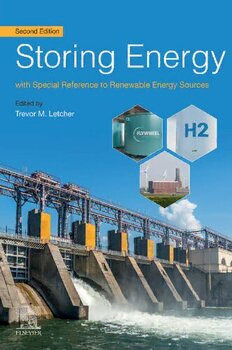
Storing Energy: with Special Reference to Renewable Energy Sources PDF
Preview Storing Energy: with Special Reference to Renewable Energy Sources
Storing Energy This page intentionally left blank Storing Energy with Special Reference to Renewable Energy Sources Second Edition Edited by Trevor M. Letcher Emeritus Professor, School of Chemistry, University of KwaZulu-Natal, Durban, South Africa Elsevier Radarweg29,POBox211,1000AEAmsterdam,Netherlands TheBoulevard,LangfordLane,Kidlington,OxfordOX51GB,UnitedKingdom 50HampshireStreet,5thFloor,Cambridge,MA02139,UnitedStates Copyright©2022ElsevierInc.Allrightsreserved. Nopartofthispublicationmaybereproducedortransmittedinanyformorbyanymeans, electronicormechanical,includingphotocopying,recording,oranyinformationstorage andretrievalsystem,withoutpermissioninwritingfromthepublisher.Detailsonhowto seekpermission,furtherinformationaboutthePublisher’spermissionspoliciesandour arrangementswithorganizationssuchastheCopyrightClearanceCenterandthe CopyrightLicensingAgency,canbefoundatourwebsite:www.elsevier.com/permissions. Thisbookandtheindividualcontributionscontainedinitareprotectedundercopyrightby thePublisher(otherthanasmaybenotedherein). Notices Knowledgeandbestpracticeinthisfieldareconstantlychanging.Asnewresearchand experiencebroadenourunderstanding,changesinresearchmethods,professional practices,ormedicaltreatmentmaybecomenecessary. Practitionersandresearchersmustalwaysrelyontheirownexperienceandknowledgein evaluatingandusinganyinformation,methods,compounds,orexperimentsdescribed herein.Inusingsuchinformationormethodstheyshouldbemindfuloftheirownsafety andthesafetyofothers,includingpartiesforwhomtheyhaveaprofessionalresponsibility. Tothefullestextentofthelaw,neitherthePublishernortheauthors,contributors,or editors,assumeanyliabilityforanyinjuryand/ordamagetopersonsorpropertyasamatter ofproductsliability,negligenceorotherwise,orfromanyuseoroperationofanymethods, products,instructions,orideascontainedinthematerialherein. LibraryofCongressCataloging-in-PublicationData AcatalogrecordforthisbookisavailablefromtheLibraryofCongress BritishLibraryCataloguing-in-PublicationData AcataloguerecordforthisbookisavailablefromtheBritishLibrary ISBN:978-0-12-824510-1 ForinformationonallElsevierpublicationsvisitourwebsite athttps://www.elsevier.com/books-and-journals Publisher:JosephP.Hayton AcquisitionsEditor:LisaReading EditorialProjectManager:LeticiaM.Lima ProductionProjectManager:SojanP.Pazhayattil CoverDesigner:MarkRogers TypesetbyTNQTechnologies Contents List ofcontributors xv Preface xxi Section A Introduction 1 1 Globalwarming,greenhouse gases, renewable energy, and storing energy 3 Trevor M. Letcher 1 Introduction 3 2 Global warmingand greenhouse gases 3 3 Carbon dioxidein theatmosphere 5 4 Renewable energy 7 5 Our presentenergy situation 7 6 The urgent needfor storing energy 10 7 Conclusion 11 References 11 2 Energy storage options tobalance renewable electricitysystems 13 Paul E. Dodds and Seamus D.Garvey 1 Introduction 13 2 The need for newtypes of storage 14 3 Storage technologies 18 4 Comparing storage systems 22 5 Challenges for energy storage 23 6 Conclusions 30 References 31 Section B Gravitational/thermomechanical storage techniques 35 3 Pumped hydro storage (PHS) 37 Julian DavidHunt,Behnam Zakeri, Andreas Nascimento and Roberto Brand~ao 1 Introduction 37 2 Storage cycles duration 42 3 Conventional arrangement types 45 vi Contents 4 Services provided by PHS plants 47 5 New arrangementsfor PHS 50 6 Pump-turbinetypes 54 7 World potential for PHS 58 8 Conclusion 59 Acknowledgments 61 References 61 4 Novelhydroelectric storage concepts 67 Frank Escombe 1 Introduction 67 2 High-density fluidPHES 69 3 Piston-in-cylinderelectrical energy storage 72 4 Endpiece 89 References 90 5 Gravity energy storage systems 91 Miles Franklin, Peter Fraenkel, Chris Yendell and Ruth Apps 1 Introduction 91 2 History 93 3 Physics 95 4 The Gravitricitysystem 102 5 Technical characteristics 107 6 Levelized cost and comparison with other technologies 111 7 Market 113 8 Gravitricity technology development 115 References 115 6 Compressed airenergystorage (CAES) 117 SeamusD. Garvey and Andrew Pimm 1 Introduction 117 2 CAES:modes ofoperationand basic principles 119 3 Aircontainments for CAES 125 4 System configurations and plant concepts 131 5 Thermal storage for CAES 135 6 Performance metrics for CAES 137 7 Integrating CAES with generationor consumption 138 8 Concluding remarks 139 References 139 Further reading 140 7 Compressed airenergystorage 141 Sabine Donadei and Gregor-S€onke Schneider 1 Introduction 141 2 Mode of operation 142 Contents vii 3 Plant concept 144 4 Undergroundstorages 147 References 154 8 Underwater compressed air energy storage 157 Andrew Pimm and SeamusD. Garvey 1 Introduction 157 2 Storage vessels for UWCAES 158 3 Anchorage and installation 163 4 System configurations 166 5 Locations 168 6 Cost and efficiency 169 7 Contrasting UWCAESwith puregravitational storage approaches indeepwater 174 8 State of development 174 9 Concluding remarks 175 References 176 9 Anovelpumped hydro combined with compressed airenergy storage system 179 Erren Yao, Hansen Zou, Ruixiong Li,Huanran Wang and Guang Xi 1 Introduction 179 2 Basic principlesof PHCA system 180 3 Characteristics ofPHCA system 181 4 Anovel constant-pressurePHCA system 182 5 Storage density analysis 183 6 Thermodynamicanalysis 184 7 Results 186 References 189 10 Liquidair energy storage 191 Yulong Ding, Yongliang Li, LigeTongandLi Wang 1 Introduction 191 2 Energy and exergy densities of liquid air 192 3 Liquid air asbotha storage medium and an efficient working fluid 194 4 Applicationsof LAES throughintegration 196 5 Technical andeconomical comparison ofLAES withother energy storagetechnologies 203 References 205 11 Flywheel energy storage 207 Keith R. Pullen 1 Introduction 207 2 Principles ofoperation 209 3 High-performanceelectric flywheelstorage systems 217 viii Contents 4 Performance attributes incomparisonwithother electrical storage technologies 227 5 Current and future applications 232 6 Conclusion 240 References 240 12 Rechargeable lithium-ion battery systems 243 Matthias Vetter and StephanLux 1 Introduction 243 2 Physicalfundamentalsof lithium-ion batteries 244 3 Development oflithium-ion batterystorage systems 244 4 System integration 259 5 Conclusions 261 References 262 Section C Electrochemical and electrical energy storage techniques 263 13 The road topotassium-ion batteries 265 Titus Masese andGodwill MbitiKanyolo 1 Introduction 265 2 The evolutionof modernbatteries 265 3 Mechanismsof lithium-ion battery operations 266 4 Cathode chemistries 269 5 Electrolytes 277 6 Anode materials 288 7 Beyondcation intercalation chemistries 294 8 Perspectives 298 Acknowledgments 300 References 300 14 Lithiumesulfur battery: Generation 5 ofbattery energy storage systems 309 Mahdokht Shaibani and Mainak Majumder 1 Introduction 309 2 Anatomyof LieS battery, challenges, and latest developments 310 3 Potential applications oflightweight LieS battery: existing, emerging, and new avenues 320 4 Conclusion and outlook: custom-designed LieS batteryis onits way 323 References 324 15 Sodiumesulfur batteries 329 Zhen Li andJingyi Wu 1 Introduction 329 2 Principles of NaeS batteries 330 Contents ix 3 Technical challenges 332 4 Cathode 334 5 Anodes 336 6 Electrolyte 338 7 Cell configuration 340 8 Conclusions and perspectives 340 References 340 16 All-solid-state batteries 343 Zhen LiandYuyuLi 1 Introduction 343 2 Solid-state electrolytes (SSEs) 343 3 Interface in ASS-L/SIBs 353 4 Conclusion 357 References 358 17 Vanadium redox flow batteries 363 Christian Doetschand Jens Burfeind 1 Introduction and historic development 363 2 The functionof theVRFB 364 3 Electrolytes ofVRFB 369 4 VRFB versus other battery types 370 5 Application of VRFB 371 6 Recycling, environment, safety, and availability 373 7 Other flow batteries 374 References 378 Furtherreading 380 18 Supercapacitors 383 Narendra Kurraand Qiu Jiang 1 Introduction 383 2 Basics ofcharge storage 384 3 Historical evolution from capacitors toelectrical double-layer capacitors 386 4 Modelsto explain electricaldouble layers 389 5 Evolutionof electrode materials for supercapacitors 394 6 State-of-the-artenergy storage technologies 396 7 Pseudocapacitiveenergy storage 397 8 Material requirements for achievingsimultaneous high energy densityat high powerdensity 400 9 Electrochemical characterization techniquesfor supercapacitors 401 10 Energy storagedevices 406 11 Applicationsof supercapacitors 411 12 Conclusions andchallenges 413 References 414
